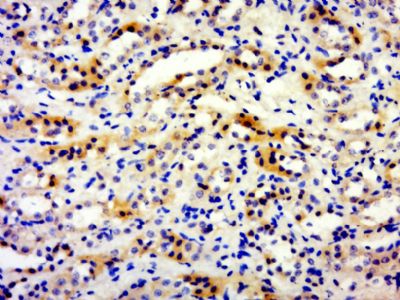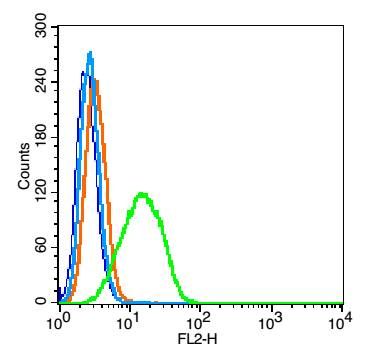Biliverdin Reductase Polyclonal Antibody
Purified Rabbit Polyclonal Antibody (Pab)
- SPECIFICATION
- CITATIONS
- PROTOCOLS
- BACKGROUND

Application
| IHC-P, IHC-F, IF, ICC, E |
|---|---|
| Primary Accession | P53004 |
| Reactivity | Rat, Pig |
| Host | Rabbit |
| Clonality | Polyclonal |
| Calculated MW | 33 KDa |
| Physical State | Liquid |
| Immunogen | KLH conjugated synthetic peptide derived from human BLVRA/Biliverdin Reductase |
| Epitope Specificity | 161-260/296 |
| Isotype | IgG |
| Purity | affinity purified by Protein A |
| Buffer | 0.01M TBS (pH7.4) with 1% BSA, 0.02% Proclin300 and 50% Glycerol. |
| SUBCELLULAR LOCATION | Cytoplasmic |
| SIMILARITY | Belongs to the Gfo/Idh/MocA family. Biliverdinreductase subfamily. |
| SUBUNIT | Monomer. |
| DISEASE | Defects in BLVRA are the cause of hyperbiliverdinemia(HBLVD) [MIM:614156]. HBLVD is a condition characterized by a greendiscoloration of the skin, urine, serum, and other bodily fluids.It is due to increased biliverdin resulting from inefficientconversion to bilirubin. Affected individuals appear to havesymptoms only in the context of obstructive cholestasis and/orliver failure. In some cases, green jaundice can resolve afterresolution of obstructive cholestasis. |
| Important Note | This product as supplied is intended for research use only, not for use in human, therapeutic or diagnostic applications. |
| Background Descriptions | In human liver cytosolic fractions, four forms of biliverdin reductase have been identified, including two biliverdin-IX Beta reductases and two biliverdin-IX Alpha reductases, designated isozymes I and II and isozymes III and IV, respectively. Biliverdin reductase A (BLVRA), also designated biliverdin-IX Alpha-reductase, belongs to the GFO/iIDH/MocA family and the biliverdin reductase subfamily. The gene that encodes this cytoplasmic protein maps to chromosome 7p14-cen. BLVRA reduces biliverdin IX ?(the ?methene bridge of the open tetrapyrrole) to bilirubin with the concomitant oxidation of an NADH or NADPH cofactor (bilirubin + NADP+ = biliverdin + NADPH). BLVRA is expressed primarily in liver. |
| Gene ID | 644 |
|---|---|
| Other Names | Biliverdin reductase A, BVR A, 1.3.1.24, Biliverdin-IX alpha-reductase, BLVRA, BLVR, BVR |
| Target/Specificity | Liver. |
| Dilution | IHC-P=1:100-500,IHC-F=1:100-500,ICC=1:100-500,IF=1:100-500,Flow-Cyt=1 µg/Test,ELISA=1:5000-10000 |
| Storage | Store at -20 ℃ for one year. Avoid repeated freeze/thaw cycles. When reconstituted in sterile pH 7.4 0.01M PBS or diluent of antibody the antibody is stable for at least two weeks at 2-4 ℃. |
| Name | BLVRA (HGNC:1062) |
|---|---|
| Function | Reduces the gamma-methene bridge of the open tetrapyrrole, biliverdin IXalpha, to bilirubin with the concomitant oxidation of a NADH or NADPH cofactor (PubMed:10858451, PubMed:7929092, PubMed:8424666, PubMed:8631357). Does not reduce bilirubin IXbeta (PubMed:10858451). Uses the reactants NADH or NADPH depending on the pH; NADH is used at the acidic pH range (6-6.9) and NADPH at the alkaline range (8.5-8.7) (PubMed:7929092, PubMed:8424666, PubMed:8631357). NADPH, however, is the probable reactant in biological systems (PubMed:7929092). |
| Cellular Location | Cytoplasm, cytosol |
| Tissue Location | Liver. |

Thousands of laboratories across the world have published research that depended on the performance of antibodies from Abcepta to advance their research. Check out links to articles that cite our products in major peer-reviewed journals, organized by research category.
info@abcepta.com, and receive a free "I Love Antibodies" mug.
Provided below are standard protocols that you may find useful for product applications.
If you have used an Abcepta product and would like to share how it has performed, please click on the "Submit Review" button and provide the requested information. Our staff will examine and post your review and contact you if needed.
If you have any additional inquiries please email technical services at tech@abcepta.com.













 Foundational characteristics of cancer include proliferation, angiogenesis, migration, evasion of apoptosis, and cellular immortality. Find key markers for these cellular processes and antibodies to detect them.
Foundational characteristics of cancer include proliferation, angiogenesis, migration, evasion of apoptosis, and cellular immortality. Find key markers for these cellular processes and antibodies to detect them. The SUMOplot™ Analysis Program predicts and scores sumoylation sites in your protein. SUMOylation is a post-translational modification involved in various cellular processes, such as nuclear-cytosolic transport, transcriptional regulation, apoptosis, protein stability, response to stress, and progression through the cell cycle.
The SUMOplot™ Analysis Program predicts and scores sumoylation sites in your protein. SUMOylation is a post-translational modification involved in various cellular processes, such as nuclear-cytosolic transport, transcriptional regulation, apoptosis, protein stability, response to stress, and progression through the cell cycle. The Autophagy Receptor Motif Plotter predicts and scores autophagy receptor binding sites in your protein. Identifying proteins connected to this pathway is critical to understanding the role of autophagy in physiological as well as pathological processes such as development, differentiation, neurodegenerative diseases, stress, infection, and cancer.
The Autophagy Receptor Motif Plotter predicts and scores autophagy receptor binding sites in your protein. Identifying proteins connected to this pathway is critical to understanding the role of autophagy in physiological as well as pathological processes such as development, differentiation, neurodegenerative diseases, stress, infection, and cancer.



